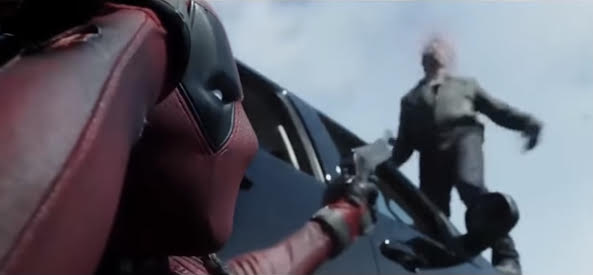Image Attribution: “Violence in Deadpool” by Debbie Guenther is licensed under CC BY-SA. (See interactive map)
Debbie Guenther
Prof. Teryl Atkins
VISA 1500
November 24, 2021
Assignment 4, Part A
Violence in movies becomes more palatable when balance between character flaw or (violent) action is offset by redeemable acts of valor or truth. This screen shot image was taken from the blockbuster action movie “Deadpool” released in 2016, a superhero story based off the Marvel comic book series Deadpool, an anti-hero who represents a morally grey villain – hero. Directed by Tim Millerand written by Rhett Reese and Paul Wernick, it was a box office sensation grossing over $700 Million, starring the very popular Ryan Reynolds, produced, and distributed by 20th Century Fox (Triana 1016). The image choice shows the typical approach to violence throughout the movie, that violence is humorous and ironic which re-enforces the anti hero genre. Benjamin Triana, of The Journal of Popular Culture defines an antihero character as, “often acts outside accepted values, norms, roles, and behaviors as a hapless everyman, a charismatic rebel, or a roguish outlaw who challenges the status quo in their often morally ambivalent quest” (1016). Triana would categorize the Deadpool character in this light as vengeful yet redeemable hero who has an impish approach to violence which is captured by the body language of Deadpool in this photograph.
In this image the masked costumed Deadpool is lying on his side on the ground in a relaxed position with his head resting on his hand and elbow bent. In a bored, absent minded way is other arm is raised and is firing a headshot at his attacker who is having his head being blown apart above him. A fast-paced, quirky scene that engages the reaction of the Deadpool’s enemies as they perceive what is happening to and around them with slow motion camera stop action that allows the viewer to see each participants face while they battle on a bridge in the middle of the day. The overall scene depicts Deadpool’s pursuit to have revenge on the individual that destroyed his life, in a typical male on male conflict, with a complete disregard of self and others. This scene is appealing to the viewer and is easy to watch due to its approach to violence that engages humor and intelligent observation, the ongoing amusing dialogue with a running joke while the violent action reduces people to a bloody mess. Keeping this in mind, the trailer for this movie used humorous clips and slap stick violence knowing it would appeal to a wider based, youth audience. Although Deadpool was rated R (ages 17 up), it was so funny and engaging, parents allowed their children to watch it. This lack of parental control is evidence of the “Ratings Creep” which defines the age group that can view the media and the descriptors of the media, “[p]ut simply, ratings creep is the process by which adult content (such as graphic violence and sexuality) is increasingly allowed into nonadult-rated movies” (Barranco 80). The line between kid appropriate viewing material and adult genre has become so blurred that rating systems that clearly defined media are now overlapping. PG 13 has sex and violence and so does R. The question remains to content, how sexual, what kind of sex, how violent, how extreme, and where is the hard line?
Work Cited
Barranco, E. Raymond. “Violence at the Box Office: Considering Ratings, Ticket Sales, and Content of Movies.” SAGE (2017): 77-95. Vol.44.
Triana, Benjamin. “Deadpool: When Our (Anti) Heros Do Less and We Reward Them More.” The Journal of Popular Culture (August 2018): 1016-1035. Vol. 51, Issue 4.
